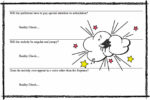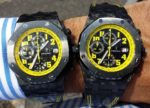Vintage PA: Pedal to the Metal
Remember the old Bugs and Daffy cartoons where Bugs repeatedly tricks Daffy into saying “Shoot me now, shoot me now” and finally when Daffy realizes the trick he responds,“Ahh, Pronoun Trouble”,followed by name calling- generally “You’re despicable!”?
A few years ago, during a lesson, a college student and I were working on pedaling in a Field Nocturne and I was having trouble understanding why he wasn’t following the pedaling on the page (Ped *). Finally, he said something like, “then why does it say Led and what are those random asterisks?” “Ahh, I said, Font Trouble.”
After we sorted out the fact that what he was seeing was actually an uppercase P and not and L, he told me that he had a friend who also thought the signs read Led. Since then, (in what can only be called cosmic unity) I have encountered the same situation with two other advancing students.
Is the computer generation so inundated with the likes of Ariel and Times New Roman that they are unable to recognize letters in other more ornate fonts? It is true that I had to go through my Mac’s quite extensive font list one by one and only found a single font (Snell Roundhand Black) that reasonably matched the font used in the score in question. However, the edition was from a well known publisher and similar fonts are used by other publishers.
The sign, of course, does not read or mean Led (although the analogy is somewhat humorous in the light of some people’s lead-footed approach to pedaling in which the aim seems to be to change it as little as possible). The first letter is an ornate upper-case P and not an L (OK- I admit does look like an L – hence the “Font Trouble”). Ped is, in reality, an abbreviation of the word Pedal. When you see the Ped, you put the right (damper) pedal down or change it. The asterisks or * are signs to release the pedal completely.
Somehow students are missing out on the fact that there are two different methods of notating pedaling. Many modern editions use only graph style pedal notation. Surely Ped * is not outdated and old fashioned or simply too European? It is, after all, found in the piano works of Aaron Copland, Richard Danielpour, Vincent Persichetti, and Ellen Taaffe Zwilich.
Pedaling Varieties
Every year, I have some students who play really very well. They have great fingers and learning habits. They feel the music. They practice. They take what we do at the lesson and make it their own. But sometimes, their playing sounds just plain dutiful. One student said her playing sounded lumpy and bumpy. Another simply said she couldn’t get the passage to sound right and didn’t know why.
I did. Pedaling trouble. Too much, to soon, too, late, too little, etc., etc., etc.
There are many pedal techniques. Some kinds of pedaling have little to do with the actual musical rhythm of the piece and a whole lot to do with movements of the hands and fingers.
Direct pedal is usually the first type of pedaling learned. The foot generally goes down exactly with the fingers. A waltz bass pedal is a kind of direct pedal. Think Oom-pah-pah. Your foot goes down when you play Oom and up on either the first or second Pah. And, just because this is called a waltz bass pedal doesn’t mean you can’t use the same technique in any meter.
Kick pedal is related to the direct pedal but is much shorter. It is used to accent or enrich a note or chord. Your foot does exactly what your hand and fingers do. The two release at exactly the same time.
Delayed, syncopated or overlapping pedal (3 names for the same technique) connects melody tones and /or changing harmonies. Let’s say you have two harmonies. You put your foot down on the first chord and leave it down until after you play the second chord. As the pedal is changed, there is a blurring of the first and second chord for a split second after which the second chord is the only one still sounding. This only works if you still have your fingers on the bottom of the second chord until your foot is down again.
If you change way too soon you chop off sounds. If your timing is a little too soon you choke the sound. This type of pedaling also only works if you actually listen to the color change as you blend the two chords. You can become very skillful at blending one into the other. As you get better at this, you can control how clean (fast change) or blurred (slower change) you want each pedal to be.
Flutter or vibrato pedaling is a technique that allows a bass note or harmony to sound through with minimal blurring to the other voices. It is essential in many romantic, impressionistic, and modern works. And incidentally, it is employed exactly as the name suggests.
The catch pedal is the most complicated to explain. No one ever told me how to do it–my ear just told my foot what it wanted to hear. Later I found out that the technique had a name and I wasn’t the only one who had ever done it. Essentially, your foot catches a harmony or note just before it changes. In catch pedaling the majority of, say a measure, is played with no pedal. Essentially you are pedaling before a note or chord to catch a harmony or single note, This allows for clean lines and textures that are not thickened. This is a very discrete pedal technique which comes in really handy in Classical and Baroque literature.
To the metal? In all kinds of pedaling, one can press the pedal down a small bit, all the way, and everything in between. This is usually referred to as half or quarter pedaling. The pedal is not an off on switch! You can change the texture and vary the color in a piece by varying the depth of the pedaling.
The Bad News?
The pedal must breathe. In order to become one with the pedal, you need to develop your ear so you can hear the effect you are trying to achieve. You can pedal the melody, the accompaniment, or any combination thereof. Also, every piano (and every room) is different so you have to constantly adjust your pedaling according to how it sounds in the room and what the instrument will do.
The Good News!
Eventually your ear and your foot communicate automatically. As you listen out into the room and combine that with what you want to hear next, your foot responds and thins out or deepens the pedaling without constant care and feeding.



